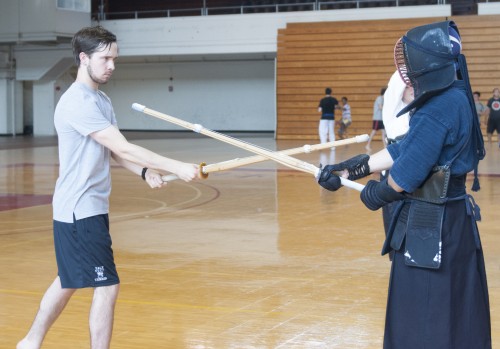 FIRST-YEAR STUDENTS PRACTICE actions with fully-equipped Kendo Club members.
FIRST-YEAR STUDENTS PRACTICE actions with fully-equipped Kendo Club members.The armory was hot on the August day that various activities were taking place around campus. Inside, the culture was completely changed, as the bamboo shinai flashed and the feet of students hit paddles instructors held high. The scene was mesmerizing, and watching the activities instilled a sense of curiosity. The Navigating Rensselaer & Beyond event exploring the martial arts consisted of three different forms: taekwondo, kendo, and kung fu, all great sources of exercise here on campus.
Taekwondo is a Korean martial art form focusing on high kicks, spinning kicks, and combining kicks. Several instructors oversaw the class, all students from RPI’s Taekwondo Club. The coach of the club had recently left, prompting many students to attempt to fill the role; one was Alan Meyhew ’17, the vice president of the club. He joined the club after his own NRB experience in taekwondo as a freshman along with fellow instructors Matt Dobbins ’18 and Joshua Aronis ’19. All three started because either they, or a friend, did martial arts during NRB, according to Aronis. Jacob Fucci ’18 views the club in a different manner, saying it has “a strong focus on personal improvement,” but that it does not stop them from competing in tournaments at other schools. He says it is a great way to see schools other than RPI.
Kendo is a form of “Japanese fencing,” according to Songhan Zhang ’17. He wore protective gear, a mask, padding, and a traditional robe-like garb. Zhang said the armor used for kendo is unique to it. The kendo stick at his side, reminiscent of a sword, is called a shinai. In one exercise, the students held out their shinai as one of the instructors ran down the line, hitting each shinai and screaming as they did so. The screams were piercing, turning heads from the other groups as well as the spectators.
Zhang enjoys the kendo club because of “the classic culture and martial arts” as well as the education of Japanese culture; hitting is just a bonus. The club is associated with the United Kendo Federation and participates in tournaments in Boston and New York City.
Kung fu is a style of martial arts originating in China and includes many different styles of fighting. It provided stark contrast to the yelling of kendo, as the demonstration is noticeably calm. The only sound is the occasional clapping of two hands coming together, making another pose in the series of movements. These movements are very structured and disciplined.
All three have similarities and differences, each choosing to focus on different aspects of martial arts. Whether you are new or experienced, learning a martial art can definitely foster individual growth.
